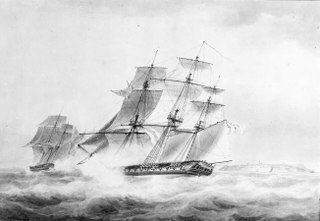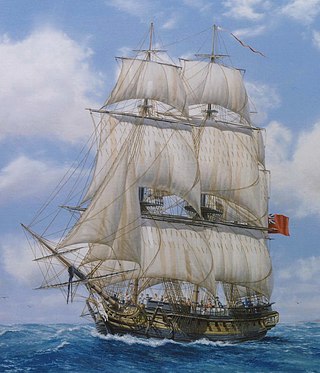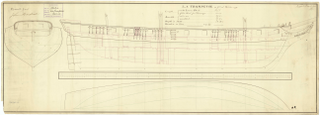
HMS Babet was a 20-gun sixth-rate post ship of the British Royal Navy. She had previously been a corvette of the French Navy under the name Babet, until her capture in 1794, during the French Revolutionary Wars. She served with the British, capturing several privateers and other vessels, and was at the Battle of Groix. She disappeared in the Caribbean in 1800, presumably having foundered.
Jean Bart may refer to one of the following ships of the French Navy or privateers named in honour of Jean Bart, a French naval commander and privateer.

HMS Phoenix was a 36-gun Perseverance-class fifth-rate frigate of the Royal Navy. The shipbuilder George Parsons built her at Bursledon and launched her on 15 July 1783. She served in the French Revolutionary and Napoleonic Wars and was instrumental in the events leading up to the battle of Trafalgar. Phoenix was involved in several single-ship actions, the most notable occurring on 10 August 1805 when she captured the French frigate Didon, which was more heavily armed than her. She was wrecked, without loss of life, off Smyrna in 1816.
Mutine was an 18-gun Belliqueuse-class gun-brig of the French Navy, built to a design by Pierre-Alexandre-Laurent Forfait, and launched in 1794 at Honfleur. She took part in the Battle of Santa Cruz de Tenerife, where the British captured her. She was recommissioned in the Royal Navy as HMS Mutine, and eventually sold in 1803.

HMS Ethalion was a 38-gun Artois-class fifth-rate frigate of the Royal Navy. She was built by Joseph Graham of Harwich and launched on 14 March 1797. In her brief career before she was wrecked in 1799 on the French coast, she participated in a major battle and in the capture of two privateers and a rich prize.

HMS Melampus was a Royal Navy fifth-rate frigate that served during the French Revolutionary and Napoleonic Wars. She captured numerous prizes before the British sold her to the Royal Netherlands Navy in 1815. With the Dutch, she participated in a major action at Algiers and, then, in a number of colonial punitive expeditions in the Dutch East Indies.

HMS Martin was a 16-gun sloop of the Royal Navy. She served at the Battle of Camperdown in 1797 and captured two privateers before she disappeared in 1800.

L'Espoir was a French brig-sloop that served for 9½ years in the French Navy before HMS Thalia captured her in September 1797. In her subsequent short career in British service as HMS Espoir she captured three prizes, with the capture in 1798 of the more heavily armed Genoese pirate Liguria earning her crew a clasp to the Naval General Service Medal. Espoir was laid up in 1799 and sold in 1804.
HMS Charlotte was a mercantile schooner that Royal Navy hired or chartered in 1796, purchased in 1797 and commissioned in 1798. In her brief military career in the Caribbean she captured two small enemy privateers before she herself fell prey to a French privateer. The British recaptured her a little more than a year later but then broke her up in 1799 rather than recommissioning her.
Several French ships have borne the name Courageux, Courageaux, or Courageuse:

The French frigate Aigle was launched in 1780 as a privateer. The French Navy purchased her in 1782, but the British captured her that same year and took her into the Royal Navy as the 38-gun fifth rate HMS Aigle. During the French Revolutionary Wars she served primarily in the Mediterranean, where she was wrecked in 1798.

Etna was a French naval Etna-class ship-sloop launched in 1795 that the Royal Navy captured in November 1796. She was taken into service as HMS Aetna and renamed to HMS Cormorant the next year. She captured several merchant vessels and privateers before she was wrecked in 1800 off the coast of Egypt.
Salamine was originally the Spanish Navy's Infante 18-gun brig, built in 1787 at Cadiz. The French Navy captured her at Toulon in December 1793 and recommissioned her; they renamed her on 10 May 1798 as Salamine, for the battle of Salamis. On 18 June 1799, HMS Emerald captured her and she was brought into Royal Navy service as HMS Salamine. She served briefly in the Mediterranean, where she captured two French privateers and several merchant vessels before the Royal Navy sold her at Malta in 1802, after the Treaty of Amiens ended the war with France.

HMS Barbuda was commissioned into the Royal Navy in 1780 after having briefly served as an American privateer. Barbuda was one of the two sloops that captured Demerara and Essequibo in 1781, but the French Navy captured her there in 1782 and took her into service as Barboude. The French Navy sold her to private owners in 1786, and she served briefly as a privateer in early 1793 before the French Navy purchased her again and named her Légère. She served them until mid-1796 when the Royal Navy captured her and took her into service as HMS Legere. She was wrecked off the coast of Colombia, without loss of life, in February 1801.
Crescent was launched at Rotherhithe in 1790. She initially traded with the Levant, particularly Smyrna. After the outbreak of war with France she may have tried her hand as a privateer. In 1796–1798 she made a voyage to the East Indies, almost surely on behalf of the British East India Company (EIC). A French privateer captured her but the British Royal Navy quickly recaptured her. In 1802-1804 she made one voyage as a slave ship carrying slaves from West Africa to Jamaica. In 1805 she became a whaler. She was lost in 1807 off Patagonia while homeward bound from her first whaling voyage.

HMS Eugenie was the French privateer Nouvelle Eugénie, launched at Nantes in 1796 that the British Royal Navy captured in 1797 and took into service. As a brig-sloop she served in the Channel, primarily escorting convoys, and was sold in 1803.
HMS Trompeuse was a former French 16-gun brig-sloop, launched in July 1793, that HMS Sphinx captured on 12 January 1794 near Cape Clear Island. The British Royal Navy took her into service. As HMS Trompeuse she captured a small privateer and then grounded off Kinsale in 1796.

HMS Trompeuse was the French privateer brig Coureur that the British Royal Navy captured in 1800. She was sold for breaking up in 1811.
Baron de Binder was launched in 1782. She made two voyages as a slave ship in the triangular trade in enslaved people. Then in 1793, she became the privateer Duguay-Trouin. After one cruise, the French Navy requisitioned her, and she served as a corvette for almost three years. The navy returned her to her owners, who sailed her as a privateer again. In 1798. the British Royal Navy captured her.
Battalion was launched at Whitby in 1795. She traded with the Baltic and then in 1796 became a Liverpool-based West Indiaman. A French privateer captured her in 1797 in a single ship action as Battalion was outbound on her first voyage to Jamaica. The Royal Navy quickly recaptured her. She was last listed in Lloyd's Register (LR) in 1797.











